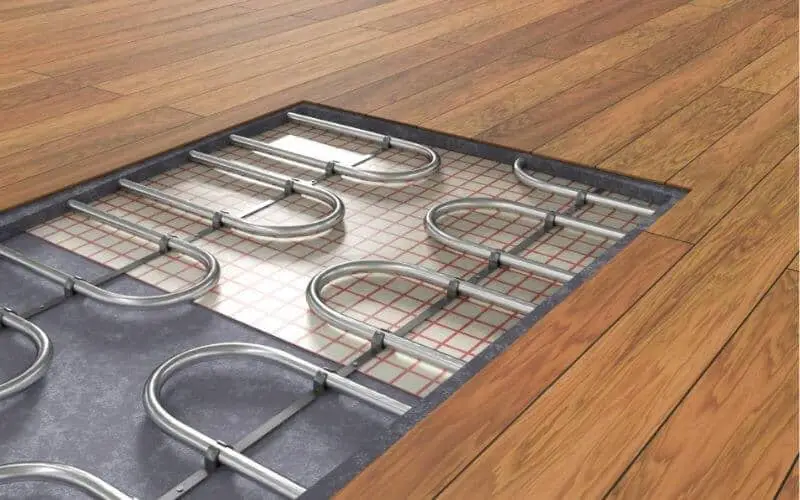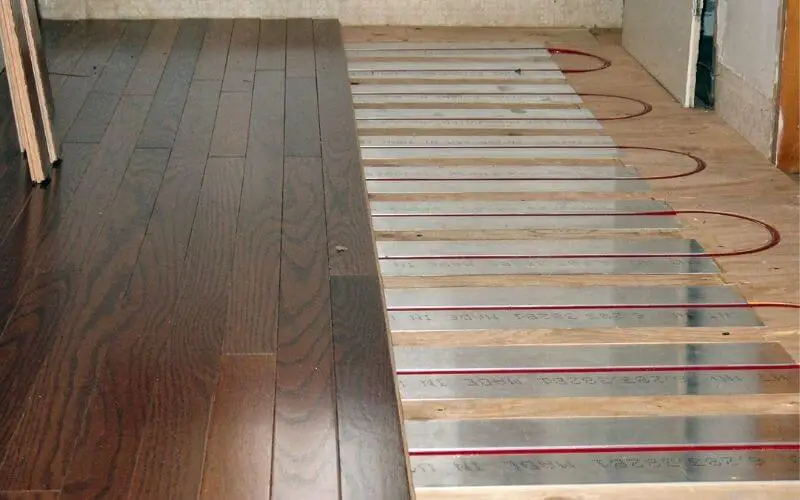Having radiant heat installed under our hardwood floor is bliss and warmth like no other. It offers a uniform temperature. It is also energy-efficient and makes the home comfortable to walk on.
This post will show how to install radiant heat under hardwood floors. Firstly, get the tools needed for the installation ready, then tighten the heat transfer plate to the underpart of the old hardwood floor with a screw. When you are done with the installation, apply three coats of adhesives to the wood floor.
Read on as we take you through the process.
Read: How to prevent footprint on hardwood floors
How to Install Radiant Heat Under Hardwood Floors
Table of Contents
Installing radiant heat under the hardwood floor is an easy task, but then, some measures should be considered for it to be a success. Failure to follow the right procedure would make everything come crashing down in failure.
We will give you a detailed format on how to install radiant heat under hardwood floors.
1. Get the tools needed to install the radiant heat under the hardwood floor. Tools like floor standing machine, notched trowel, woody putty, hammer, drill, pneumatic nails – 18-gauge, drill bit, chisel. These tools would be very necessary for the long run.
2. Tighten the heat transfer plate to the underpart of the old hardwood floor with a screw. Put in two similar layers of the plate in between each set of the floor joist.
3. Clamp the flexible PEX tube into the lines of the heat transfer plates. Then, bore a 5/8 inches hole into the floor joist to continue your tubing process.
4. Remember to cover the tubing and transfer plate with aluminum foil.
5. Apply open-cell foam insulation in the middle of the floor joist, covering the aluminum foil and insulating the tube.
6. Using a notched trowel, spread the flooring mastic all over the hardwood floor. To avoid the flooring mastic from drying out, work on each section at a time.
7. Set the new hardwood flooring onto the flooring mastic. Then, clamp it with a pneumatic nail – an 18-gauger filled with 1-inch nails.
8. Using a hammer and chisel, pry the floorboards together after fastening the nails.
9. Fill in the nail holes, advisably, with wood putty. Also, sand the floor till it is smooth.
10. Use, at the very least, three coats of polyurethane adhesive to the hardwood floor.
Read: Is vinyl flooring heat resistant
Things to Consider Before Installing Radiant Heat Under Hardwood Floors
Installing radiant heat in the home is a very welcomed development as it leaves the floor warm and cozy. But then, certain aspects require attention before you install radiant heat to avoid regrets in the long run.
Here are things to ask yourself if you plan to install radiant heat under hardwood floors.
1. Is it the Best Choice for Me and My Home?
The idea of having your hardwood floor warm is very sensational. But it doesn’t just end there. If you are installing radiant heat in an old house, it would mean your floor is pulled out for days, if not weeks. Are you sure you have it all planned out already?
Radiant heat is a better choice for certain home structures. Houses with high roofs and wide rooms can also profit from this, but the traditional heating routine ends up wasting lots of energy in these houses due to how high and vast it is. These are things to be put into consideration.
2. Can I afford the cost?
Radiant heat years back used to be an extravagance found only in top homes, making it expensive. Thanks to the advancement in technology, the cost of installing radiant heat has reduced considerably.
But then, a need might arise for you to call on the professionals for help and advice at some point. And all this put together might be a bit costly. Be sure to know if you can afford the cost and procedures required in installing it in your home.
3. Would the Type of Hardwood I have Work with Radiant Heat?
Do you want to keep your current hardwood? Or are you making plans to purchase a new hardwood? Is it a suitable flooring type for radiant heat?
Though many hardwoods can work with radiant heat, a selected few are not suitable for radiant heat. So be careful with your choice of wood flooring.
Read: How to fix hollow spots in hardwood floors
Conclusion
This post has covered detailed steps on how to install radiant heat under hardwood floor. Installing radiant heat under wood floor makes the floor warm and comfortable. However, some steps are required in actualizing this process, which we have listed above.

